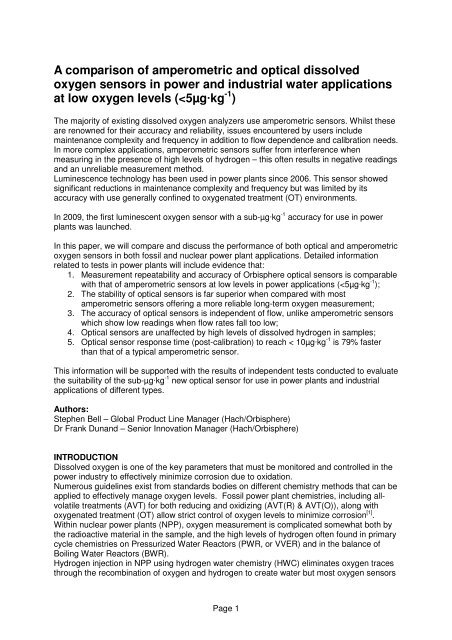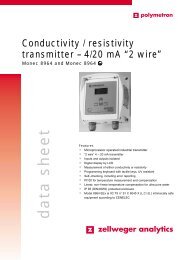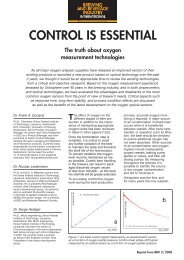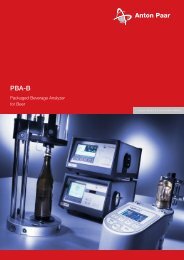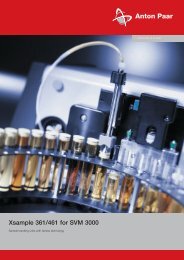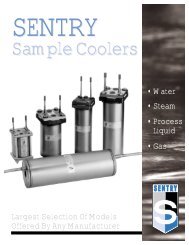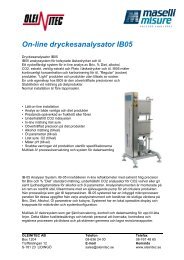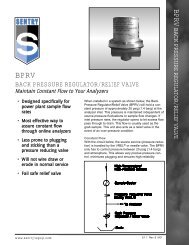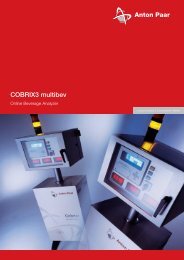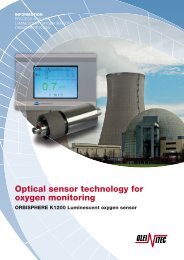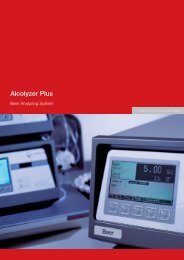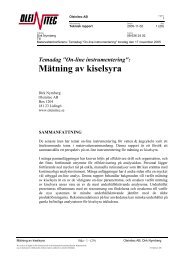A comparison of amperometric and optical dissolved oxygen ... - Hach
A comparison of amperometric and optical dissolved oxygen ... - Hach
A comparison of amperometric and optical dissolved oxygen ... - Hach
Create successful ePaper yourself
Turn your PDF publications into a flip-book with our unique Google optimized e-Paper software.
A <strong>comparison</strong> <strong>of</strong> <strong>amperometric</strong> <strong>and</strong> <strong>optical</strong> <strong>dissolved</strong><br />
<strong>oxygen</strong> sensors in power <strong>and</strong> industrial water applications<br />
at low <strong>oxygen</strong> levels (
suffer from interference from elevated hydrogen levels. The critical nature <strong>of</strong> the<br />
hydrogen/<strong>oxygen</strong> mixture means accurate measurement accounting for any hydrogen<br />
interference is essential.<br />
The effects <strong>of</strong> hydrogen present in water can also be seen in stator water cooling<br />
applications – the most commonly used chemistry is a low <strong>oxygen</strong> monitoring approach, with<br />
a typical range <strong>of</strong> 1-10µg·kg -1 <strong>oxygen</strong> but this cooling water is generally saturated with<br />
hydrogen [2] . Again, for safety in addition to corrosion control reasons, the <strong>oxygen</strong> level must<br />
be accurately measured.<br />
POWER INDUSTRY TRENDS<br />
Over the past decade a number <strong>of</strong> trends have started to gain pace within the power sector,<br />
driving a change in instrumentation requirements for operations managers <strong>and</strong> plant<br />
chemists.<br />
Firstly, maintenance <strong>and</strong> operations budget cuts have resulted in fewer plant personnel. This<br />
in turn has forced plant personnel to optimize even further their daily work <strong>and</strong> reduce their<br />
maintenance <strong>and</strong> calibration workload. Accompanied by the switch to inline/in-process<br />
rather than lab measurements, this puts additional time pressure on maintenance personnel.<br />
Secondly, as the cost <strong>of</strong> building new power plants spirals upwards, many operators now<br />
look to plant life-extensions as a solution to bridge gaps in production capacity at a lower<br />
investment premium. Construction cost increases are compounded by fears over the cost <strong>of</strong><br />
new carbon capture systems <strong>of</strong>ten dem<strong>and</strong>ed on new plants.<br />
Clearly, plant extensions are only possible if the heart <strong>of</strong> any power plant, the water-steam<br />
circuit, can be well managed <strong>and</strong> maintained – this augments the importance <strong>of</strong> chemistry<br />
managers <strong>and</strong> the role <strong>of</strong> reliable instrumentation in plant operations.<br />
Thirdly, there are a growing number <strong>of</strong> peaking plants in the power sector, especially with the<br />
advances in <strong>and</strong> environmental benefits <strong>of</strong> combined-cycle gas turbine (CCGT) peaking<br />
plants [3] . Peaking plants experience more power-up/-down cycles than base-load plants <strong>and</strong><br />
each <strong>of</strong> these results in high <strong>oxygen</strong> concentrations during the start-up. This in turn leads to<br />
higher instrument maintenance <strong>of</strong> <strong>amperometric</strong> sensors for <strong>oxygen</strong> measurement, a real<br />
problem for operations managers looking for low maintenance systems.<br />
These major trends have altered power plant operational needs. This paper will build on<br />
these trends with analysis looking for: <strong>oxygen</strong> measurements that are accurate, reliable,<br />
stable, <strong>and</strong> above all, that require low- or zero-maintenance.<br />
Given these industry trends, different chemistry guidelines, <strong>and</strong> the multitude <strong>of</strong><br />
measurement options <strong>and</strong> vendors available today, we will c<strong>and</strong>idly discuss two popular<br />
technologies: <strong>amperometric</strong> <strong>and</strong> <strong>optical</strong>, along with the benefits <strong>and</strong> limitations <strong>of</strong> each.<br />
BACKGROUND AND HISTORY OF OPTICAL OXYGEN MEASUREMENT<br />
Optical measurement <strong>of</strong> <strong>oxygen</strong> has been discussed in a number <strong>of</strong> different papers <strong>and</strong> is<br />
now widely accepted in several industries including monitoring aquatic biology in waste<br />
water [4] , blood gas analysis [5] , fermentation control in biotechnology processes [6] , wine micro<strong>oxygen</strong>ation<br />
[7] , <strong>and</strong> waste-water <strong>oxygen</strong> analysis [8] .<br />
The use <strong>of</strong> Luminescent Dissolved Oxygen (LDO®) sensors for the measurement <strong>of</strong> <strong>oxygen</strong><br />
is now accepted by ASTM [9] – with ten’s <strong>of</strong> thous<strong>and</strong>s <strong>of</strong> units in use globally, LDO®<br />
measurement has been rapidly adopted by users in many industries.<br />
Optical measurement started with the measurement <strong>of</strong> relatively high <strong>oxygen</strong> levels, with<br />
measurements at mg·kg -1 level samples now widely accepted <strong>and</strong> used in process.<br />
Technology advances over the past 3years have resulted in µg·kg -1 measurement systems in<br />
the power industry [10] however accurate <strong>and</strong> consistent measurement at levels below<br />
Page 2
10µg·kg -1 were limited due to the accuracy <strong>and</strong> detection limits available at that time,<br />
however since 2009, accurate measurement at levels below 1µg·kg -1 have now been made<br />
possible.<br />
PRINCIPLE OF MEASUREMENT<br />
Optical sensing <strong>of</strong> <strong>oxygen</strong> is based on the measurement <strong>of</strong> the red fluorescence <strong>of</strong> a<br />
dye/indicator illuminated with a modulated blue light as shown in Figure 1.<br />
Figure 1: Principle <strong>of</strong> <strong>optical</strong> <strong>oxygen</strong> detection using fluorescent dye<br />
The presence <strong>of</strong> <strong>oxygen</strong> results in a phase shift <strong>of</strong> the red fluorescence light when compared<br />
to the modulated blue light source – by measuring this phase shift, it is possible to make a<br />
direct measurement <strong>of</strong> the <strong>oxygen</strong> concentration in the sample. Much greater detail <strong>of</strong> this<br />
technique has been discussed in past papers from Dun<strong>and</strong> et al [11] .<br />
SYSTEM CALIBRATION<br />
Calibration is the bane <strong>of</strong> most chemistry engineers – when accurate measurement is<br />
important, more frequent calibration is <strong>of</strong>ten applied to reduce the risk <strong>of</strong> measurement drift.<br />
Often time consuming, awkward <strong>and</strong> cumbersome, chemicals <strong>and</strong> st<strong>and</strong>ards are needed for<br />
the intricate calibration <strong>and</strong> verification <strong>of</strong> <strong>oxygen</strong> sensors.<br />
Amperometric <strong>oxygen</strong> sensors generally require a two-point calibration – the zero point <strong>and</strong><br />
the slope (via st<strong>and</strong>ards calibration sample). The exception to this rule being the Orbisphere<br />
<strong>amperometric</strong> sensor which only requires a single-point calibration in air to determine the<br />
slope due to its “true zero” – to this day, this sensor is still seen as the industry reference in<br />
<strong>oxygen</strong> measurement.<br />
Optical <strong>oxygen</strong> sensors require a single-point zero-calibration. The single point calibration is<br />
used to set the zero – this is where the <strong>optical</strong> signal varies the most hence an accurate<br />
setup is essential if accurate measurement below 1µg·kg -1 is required.<br />
In the past months, a number <strong>of</strong> questions regarding calibration <strong>of</strong> <strong>optical</strong> sensors have<br />
arisen with talk <strong>of</strong> “inline calibration” methods – what sounds like nirvana comes with serious<br />
short-comings. “Inline-calibration” in reality aligns the system with an external reference<br />
reading – applying an “<strong>of</strong>fset”. This does not calibrate the system within a range nor set the<br />
zero-point accurately. If a system has been correctly calibrated, this concept does however<br />
<strong>of</strong>fer a method <strong>of</strong> improving the reproducibility <strong>of</strong> a system IF a very reliable external<br />
reference source exists.<br />
The big advantage <strong>of</strong> <strong>optical</strong> calibration is that no chemicals are required. The sensor can be<br />
calibrated using a pure <strong>oxygen</strong> free gas such as nitrogen or carbon-dioxide with no other<br />
liquids required for cleaning due to the sensor being electrolyte-free. The only reliable<br />
calibration method remains to expose the sensor during calibration to a known reference<br />
sample to adjust the zero-point.<br />
Page 3
Orbisphere recommends the use <strong>of</strong> a quality-50 gas as a reference zero value, giving<br />
99.999% purity which helps ensure accuracy at sub-µg·kg -1 measurement levels.<br />
Figure 2 compares the maintenance, calibration, stabilization, <strong>and</strong> response time <strong>of</strong> an<br />
<strong>optical</strong> sensor when compared with that <strong>of</strong> an <strong>amperometric</strong> sensor. This shows that the<br />
maintenance <strong>and</strong> stabilization time <strong>of</strong> an <strong>optical</strong> sensor is 82% less than that <strong>of</strong> a typical<br />
<strong>amperometric</strong> sensor – when combined with the fact that maintenance is required 3 times<br />
less than an <strong>amperometric</strong> sensor, the operator workload can be reduced by 95% – such<br />
time <strong>and</strong> cost savings become significant within a power plant with a multitude <strong>of</strong> <strong>oxygen</strong><br />
sensors.<br />
Figure 2: Maintenance, calibration, <strong>and</strong> stabilization timeline for an <strong>optical</strong> vs an <strong>amperometric</strong> sensor.<br />
This also demonstrates that <strong>optical</strong> sensor response time (post-calibration) from air to reach<br />
4µg·kg -1 is 79% faster than that <strong>of</strong> a typical <strong>amperometric</strong> sensor, resulting in more system<br />
up-time <strong>and</strong> much lower operator intervention.<br />
COMPARATIVE TESTS AND INSTALLATIONS<br />
Many different tests have been performed in power plant environments globally to<br />
demonstrate the significant benefits that can be achieved by using <strong>optical</strong> <strong>oxygen</strong> sensors<br />
when compared with <strong>amperometric</strong> sensors.<br />
Data discussed <strong>and</strong> illustrated in this paper includes that from the following installations:<br />
1. Combined cycle power plant (gas <strong>and</strong> steam); 1000MW capacity running an AVT<br />
water chemistry.<br />
• Feedwater <strong>oxygen</strong> measurement; typical values in the 0-10µg·kg -1 range at<br />
temperatures <strong>of</strong> 15-25°C.<br />
• Within the AVT chemistry, Carbohydrazine <strong>and</strong> ammonia were present.<br />
• Both the Orbisphere K1100 <strong>optical</strong> sensor <strong>and</strong> the Orbisphere A1100<br />
<strong>amperometric</strong> sensors were installed.<br />
Page 4
2. BWR Nuclear power plant; 355MW capacity running a hydrogen water chemistry<br />
(HWC).<br />
• Reactor water measurement; typical values below 1µg·kg -1 during hydrogen<br />
injection (during normal operation) at temperatures <strong>of</strong> 18-23°C.<br />
• Hydrogen present in feedwater at 180µg·kg -1 ; radiation level <strong>of</strong> approximately<br />
160µSv·h -1 .<br />
Power plants operating with AVT water chemistries typically require lower level <strong>and</strong> hence<br />
more accurate <strong>oxygen</strong> measurement than those running OT water chemistries. The <strong>oxygen</strong><br />
levels commonly encountered within fossil power plants have been discussed in prior papers<br />
by Dooley et al [12] . Given such varying concentrations <strong>and</strong> water chemistries, a clear<br />
underst<strong>and</strong>ing <strong>of</strong> the factors impacting system performance is essential.<br />
SENSOR REPEATABILITY AND STABILITY<br />
Oxygen levels in power plant applications <strong>and</strong> their monitoring depend heavily on the<br />
measurement point <strong>and</strong> water chemistry in question.<br />
Whilst some <strong>amperometric</strong> sensors can measure with an accuracy <strong>of</strong> 0.1µg·kg -1 , this is<br />
balanced with a number <strong>of</strong> drawbacks:<br />
1. Stability or drift between maintenance interventions;<br />
2. Effort <strong>and</strong> costs associated with minimizing errors due to drift through more regular<br />
calibration <strong>and</strong> sensor maintenance.<br />
For this reason, it is essential to consider the <strong>oxygen</strong> levels to be measured along with the<br />
constraints <strong>of</strong> time <strong>and</strong> the confidence to be placed in a system.<br />
Before the merits <strong>of</strong> the different technologies are discussed, it would be wise to define a<br />
number <strong>of</strong> key measures that are <strong>of</strong>ten overlooked by vendors:<br />
1. Repeatability: the ability <strong>of</strong> a given sensor/system to consistently measure time <strong>and</strong><br />
again a reference sample.<br />
2. Reproducibility: the deviation in readings from one sensor/system to another in the<br />
same reference sample.<br />
3. Accuracy: a measure <strong>of</strong> the trueness <strong>of</strong> a system when comparing the measured <strong>and</strong><br />
actual values.<br />
4. Stability: how the accuracy <strong>of</strong> a sensor/system differs over time.<br />
These metrological terms <strong>and</strong> definitions are widely accepted [13] however contrary to popular<br />
belief; there is no definition <strong>of</strong> precision in the measurement <strong>of</strong> water chemistry parameters.<br />
Given these varied definitions along with the most commonly implemented water chemistries<br />
discussed earlier, we will discuss system repeatability <strong>and</strong> stability – discussing how<br />
accurately a system can measure <strong>and</strong> also how well a system performs over time (stability),<br />
<strong>of</strong>ten referred to with a measure <strong>of</strong> drift.<br />
Most systems tend to measure well after calibration however close to 100% <strong>of</strong><br />
measurements are completed when a systems’ longer-term performance starts to play a<br />
major role hence the elevated importance <strong>of</strong> any <strong>oxygen</strong> systems’ repeatability <strong>and</strong> stability.<br />
Repeatability<br />
System repeatability varies greatly based on the system in addition to the various<br />
technologies <strong>and</strong> controllers used. It is essential to note that the better the repeatability <strong>of</strong> a<br />
system, the less noisy the measurement is.<br />
Figure 3 illustrates a comparative test completed between an Orbisphere A1100<br />
<strong>amperometric</strong> sensor, <strong>of</strong>ten considered the reference for online <strong>oxygen</strong> measurement, <strong>and</strong><br />
an Orbisphere K1100 <strong>optical</strong> sensor.<br />
Page 5
Figure 3: Comparative test <strong>of</strong> an Orbisphere K1100 <strong>optical</strong> <strong>and</strong> A1100 <strong>amperometric</strong> sensors in an<br />
AVT water chemistry, boiler feedwater application.<br />
The Orbisphere K1100 <strong>optical</strong> sensor is shown to measure with a repeatability (r 95 ) <strong>of</strong><br />
±0.1µg·kg -1 at levels below 5µg·kg -1 . This repeatability is comparable with the most accurate<br />
<strong>amperometric</strong> sensors available whose repeatability (r 95 ) <strong>of</strong> ±0.1µg·kg -1 is equivalent to that<br />
demonstrated by the Orbisphere K1100 <strong>optical</strong> sensor. This <strong>of</strong>fers excellent measurement<br />
accuracy in power plant applications for OT, AVT, <strong>and</strong> NPP chemistries<br />
Stability<br />
Sensor drift is THE major cause <strong>of</strong> concern for plant operators <strong>and</strong> can result in excessive<br />
calibration <strong>and</strong> maintenance.<br />
The stability <strong>of</strong> a system directly impacts the confidence placed in it over time – a system that<br />
drifts significantly will never be trusted as the source <strong>of</strong> information in process control. With a<br />
number <strong>of</strong> systems publishing a drift <strong>of</strong> ±5% [14] <strong>and</strong> up to ±2µg·kg -1 per week in the measured<br />
values [15] , this leads to frequent operator intervention for calibration <strong>and</strong> a lack <strong>of</strong> trust in the<br />
system. Such drift <strong>of</strong> up to ±2µg·kg -1 per week in applications below 5µg·kg -1 is not<br />
acceptable for many operators in fossil plant chemistries.<br />
With the stability or drift <strong>of</strong> a system playing such an important role in measurement during<br />
time between calibrations, it is really the overlying factor in all <strong>oxygen</strong> measurement systems.<br />
Figure 4 illustrates the impact <strong>of</strong> an <strong>amperometric</strong> sensor drifting ±2µg·kg -1 per week <strong>and</strong> the<br />
frequency <strong>of</strong> calibration required for such systems when compared to both a typical<br />
<strong>amperometric</strong> system <strong>and</strong> also the Orbisphere K1100 <strong>optical</strong> sensor if recalibration is<br />
required when drift amounts to 2µg·kg -1 .<br />
Page 6
Figure 4: Comparing the drift <strong>of</strong> different sensors <strong>and</strong> its impact on calibration requirements when<br />
measuring at 4µg·kg -1 levels<br />
Amperometric sensors suffer drift when the electrolyte ages (being consumed by the <strong>oxygen</strong><br />
measured) resulting in the sensor becoming less responsive.<br />
When higher <strong>oxygen</strong> levels are measured, for example, as part <strong>of</strong> plant start-up or shutdown,<br />
this drift becomes even more pronounced – all this at the time when measurements should<br />
be the most accurate as equipment is brought online <strong>and</strong> high <strong>oxygen</strong> levels are to be<br />
expected – protecting capital equipment here is key.<br />
With <strong>optical</strong> technology, long-term aging <strong>of</strong> the luminescent spot causes upwards drift <strong>and</strong><br />
results in a rise in measured values. The technology used within the Orbisphere K1100<br />
<strong>optical</strong> system results in a far superior stability <strong>and</strong> an interval between calibrations <strong>of</strong> 12<br />
months. So as time between calibrations increases <strong>and</strong> the variability from stability <strong>and</strong> drift<br />
play an increased role, <strong>optical</strong> systems <strong>of</strong>fer an additional level <strong>of</strong> protection <strong>and</strong><br />
reassurance.<br />
SYSTEM PERFORMANCE IN HYDROGEN RICH SAMPLES<br />
As previously mentioned, NPP measurements in the PWR primary cycle, where highly<br />
precise readings are required, can be more troublesome for <strong>amperometric</strong> sensors. Often<br />
primary cycle chemistries include high levels <strong>of</strong> hydrogen in the measurement sample –<br />
<strong>amperometric</strong> sensors can experience a negative <strong>of</strong>fset from high levels <strong>of</strong> hydrogen, at<br />
times up to -10µg·kg -1 . Whilst systems do exist to compensate for this <strong>of</strong>fset [16] , accurate<br />
<strong>oxygen</strong> readings are critical to plant operation in both HWC <strong>and</strong> NWC plants [17] .<br />
The advantage <strong>of</strong> <strong>optical</strong> technology in NPP water chemistries is that <strong>optical</strong> sensors are<br />
unaffected by high levels <strong>of</strong> hydrogen in the measurement sample – when measuring low<br />
levels <strong>of</strong> <strong>oxygen</strong>, this is a critical feature.<br />
Table 1 compares tests <strong>of</strong> the Orbisphere K1200 <strong>optical</strong> sensor (a derivative <strong>of</strong> the K1100 for<br />
radioactive applications) to values measured by an <strong>amperometric</strong> sensor without any<br />
hydrogen compensation features in primary cycle PWR water by an independent testing<br />
Page 7
group [18] . A hydrogen pressure <strong>of</strong> ~2.3bar (abs) was set with <strong>dissolved</strong> hydrogen<br />
concentrations <strong>of</strong> 3.36mg·kg -1 . Values illustrated show a mean result over 5 measurement<br />
points <strong>and</strong> 4 measurement cycles.<br />
Dissolved Oxygen Readings (µg·kg -1 )<br />
Amperometric Sensor K1100 Optical Sensor<br />
Cycle 1 -3.2 1<br />
Cycle 2 -3.2 0.2<br />
Cycle 3 -3.5 0.3<br />
Cycle 4 -3.5 0.9<br />
Table 1: Comparison <strong>of</strong> the Orbisphere K1200 <strong>optical</strong> sensor <strong>and</strong> an <strong>amperometric</strong> sensor in PWR<br />
primary conditions<br />
This <strong>comparison</strong> shows the negative <strong>of</strong>fset experienced by <strong>amperometric</strong> sensors in the<br />
presence <strong>of</strong> hydrogen whilst the Orbisphere K1200 <strong>optical</strong> sensor remains unaffected by<br />
high levels <strong>of</strong> <strong>dissolved</strong> hydrogen.<br />
Figure 5 illustrates the performance <strong>of</strong> the Orbisphere K1200 <strong>optical</strong> system online in a HWC<br />
nuclear chemistry when compared with a reference Orbisphere A1100 <strong>amperometric</strong> system<br />
configured with hydrogen compensation. It can be seen that that the Orbisphere K1200<br />
<strong>optical</strong> system repeatability within an HWC chemistry at <strong>oxygen</strong> levels < 0.5µg·kg -1 is<br />
excellent <strong>and</strong> is unaffected by the presence <strong>of</strong> hydrogen.<br />
Figure 5: Comparison <strong>of</strong> the Orbisphere K1200 <strong>optical</strong> sensor with an <strong>amperometric</strong> sensor in an<br />
HWC nuclear chemistry.<br />
Figure 6 shows the Orbisphere K1200 in a reactor water application as the <strong>oxygen</strong> level<br />
drops <strong>and</strong> then stabilizes at a 0.4µg·kg -1 level. Again, the Orbisphere K1200 illustrates a<br />
repeatability < 0.1µg·kg -1 , <strong>of</strong>fering excellent consistency at very low <strong>oxygen</strong> levels.<br />
Page 8
Figure 6: Orbisphere K1200 <strong>optical</strong> sensor in a BWR reactor water application after start-up.<br />
SYSTEM PERFORMANCE UNDER THE INFLUENCE OF FLOW VARIATIONS<br />
Within any power plant, the performance <strong>of</strong> any sampling system plays a role in the accuracy<br />
<strong>of</strong> most analytical systems. When flow is reduced below recommended levels, this can<br />
impact the accuracy <strong>of</strong> the measurement systems. Figure 7 shows how the performance <strong>of</strong><br />
the Orbisphere K1100 <strong>optical</strong> sensor is independent <strong>of</strong> flow when compared with an<br />
<strong>amperometric</strong> sensor.<br />
The <strong>optical</strong> system only requires enough flow to provide a fresh sample whereas<br />
<strong>amperometric</strong> sensors have a range <strong>and</strong> minimal flow levels below which measurement<br />
errors could be encountered. For example, a flow rate that is 30% lower than a<br />
recommended minimum would likely result in an error <strong>of</strong> up to 10%.<br />
Page 9
Figure 7: Comparison <strong>of</strong> an <strong>amperometric</strong> sensor with the Orbisphere K1100 experiencing variations<br />
in flow.<br />
CONCLUSIONS<br />
We have compared <strong>and</strong> discussed the performance <strong>of</strong> both <strong>optical</strong> <strong>and</strong> <strong>amperometric</strong><br />
<strong>oxygen</strong> sensors in fossil <strong>and</strong> nuclear power plant applications<br />
The measurement <strong>and</strong> control <strong>of</strong> <strong>dissolved</strong> <strong>oxygen</strong> levels in power plant chemistry has never<br />
been so critical. With the number <strong>of</strong> qualified maintenance engineers continually declining,<br />
<strong>and</strong> greater economic pressure on plant operators to protect <strong>and</strong> maximize the useable life <strong>of</strong><br />
capital equipment, the time available to maintain instrumentation is <strong>of</strong> critical importance.<br />
We have shown through comparative tests that the repeatability <strong>of</strong> the Orbisphere K1100<br />
sensor is comparable with that <strong>of</strong> the Orbisphere <strong>amperometric</strong> sensor when used in power<br />
<strong>and</strong> industrial water applications, especially at levels below 5µg·kg -1 . In terms <strong>of</strong> stability, the<br />
Orbisphere K1100 <strong>optical</strong> sensor has proven to be far superior to <strong>amperometric</strong> sensors with<br />
a calibration interval <strong>of</strong> 12 months with no intermediate intervention required during this<br />
period.<br />
In the comparative tests completed, the Orbisphere K1100 has proven its accuracy to be<br />
independent <strong>of</strong> flow variations <strong>and</strong> the Orbisphere K1200 showed no interference from<br />
elevated hydrogen concentrations in radioactive applications – both these points provide for<br />
additional confidence in measured values.<br />
In terms <strong>of</strong> response time <strong>and</strong> maintenance efforts, the Orbisphere K1100 <strong>optical</strong> sensor<br />
response time (post-calibration) to reach 4µg·kg -1 was 79% faster than that <strong>of</strong> the fastest<br />
<strong>amperometric</strong> sensor <strong>and</strong> the reduction in calibration <strong>and</strong> maintenance efforts over the best<br />
<strong>amperometric</strong> sensors amounts to a 95% reduction in maintenance efforts.<br />
Page 10
The Orbisphere K1100 <strong>and</strong> the technical advances it brings to customers <strong>of</strong>fer the most time<br />
<strong>and</strong> cost effective solution for accurate <strong>oxygen</strong> monitoring available. With a demonstrated<br />
repeatability <strong>of</strong> ±0.1µg·kg -1 <strong>and</strong> the possibility to measure continuously over a 12 month<br />
period without any calibration or user intervention, the Orbisphere K1100 sets a new<br />
st<strong>and</strong>ard for <strong>oxygen</strong> measurement in power plants.<br />
THE AUTHORS<br />
Stephen Bell – Global Product Line Manager (<strong>Hach</strong>/Orbisphere)<br />
Stephen joined Orbisphere in 2006 as the Global Power Market Manager, <strong>and</strong> was promoted<br />
in 2008 to his current position <strong>of</strong> Global Product Line Manager for all <strong>dissolved</strong> gases<br />
products, including the Orbisphere product line.<br />
Prior to joining <strong>Hach</strong>-Orbisphere, Stephen worked across Europe in the consumer goods <strong>and</strong><br />
consulting sectors for several years <strong>and</strong> co-founded <strong>and</strong> built up a s<strong>of</strong>tware company.<br />
Stephen received a Masters degree in Engineering Science from the University <strong>of</strong> Durham,<br />
UK, <strong>and</strong> completed an MBA at IMD, Lausanne, Switzerl<strong>and</strong>.<br />
Dr Frank Dun<strong>and</strong> – Senior Innovation Manager (<strong>Hach</strong>/Orbisphere)<br />
Frank joined Orbisphere in 2002 as a Product Manager, was then promoted to Senior<br />
Product Manager heading the team managing all Orbisphere <strong>and</strong> POLYMETRON products.<br />
Frank currently holds global responsibility for product innovation at the <strong>Hach</strong>-Lange facility in<br />
Geneva, Switzerl<strong>and</strong>. He has been the author <strong>of</strong> 16 technical papers in the analytical<br />
chemistry field.<br />
Frank received his Ph.D. in Chemistry from the Swiss Federal Institute <strong>of</strong> Technology,<br />
Lausanne, Switzerl<strong>and</strong>; <strong>and</strong> an M.S. in Chemistry from the University <strong>of</strong> Fribourg,<br />
Switzerl<strong>and</strong>.<br />
CONTACT<br />
Stephen Bell<br />
Global Product Line Manager<br />
HACH LANGE SARL<br />
6 Route de Compois<br />
CP212<br />
CH-1222 Vésenaz<br />
Switzerl<strong>and</strong><br />
Email: stephen.bell@hach-lange.com<br />
Frank Dun<strong>and</strong><br />
Senior Innovation Manager<br />
HACH LANGE SARL<br />
6 Route de Compois<br />
CP212<br />
CH-1222 Vésenaz<br />
Switzerl<strong>and</strong><br />
Email: frank.dun<strong>and</strong>@hach-lange.com<br />
REFERENCES<br />
1 Dooley, B., Shields, K. ; Cycle Chemistry for Conventional Fossil Plants <strong>and</strong> Combined Cycle/HRSGs –<br />
PPChem 2004, 6(3).<br />
Page 11
2 McInnes, D. ; Stator Cooling Water De<strong>oxygen</strong>ation Control at Tarong Power Station – PPChem 2006, 8(5)<br />
3 Smith, Rebecca. ; Turmoil in Power Sector – Wall Street Journal - Politics, 14/01/2010.<br />
4 <strong>Hach</strong> Company ; HACH LDO® Dissolved Oxygen Probe – LIT 2455, 07/2007.<br />
5 Osmetech, USA ; OPTI® CCA Blood Gas Analyzer.<br />
6 Lindblom, T. ; Qualitative Comparison <strong>of</strong> Optical <strong>and</strong> Amperometric Sensors for measuring Dissolved Oxygen<br />
in Bioreactors – Linköping University, Institute <strong>of</strong> Technology – 03/2009.<br />
7 Pütz, Petra ; Determination <strong>of</strong> <strong>oxygen</strong> in wine – <strong>Hach</strong> Lange Applications, 07/2008, DOC042.52.20018.Jul08.<br />
8 <strong>Hach</strong> Company ; Case History: Bristol-Myers Squibb/<strong>Hach</strong> Process Luminescence DO – S-P250, 07/2004.<br />
9 ASTM International; St<strong>and</strong>ard Test Methods for Dissolved Oxygern in Water – D 888 – 005.<br />
10 Dun<strong>and</strong>, F. et al. ; Luminescent <strong>oxygen</strong> sensor to monitor power plant water <strong>and</strong> team cycles – PPChem 2006,<br />
8(10).<br />
11 Dun<strong>and</strong>, F. et al. ; Efficiency <strong>and</strong> benefits <strong>of</strong> a luminescent <strong>oxygen</strong> sensor to monitor <strong>dissolved</strong> <strong>oxygen</strong> in<br />
power plants – API 2008.<br />
12 Dooley, B., Shields, K. ; Cycle Chemistry for Conventional Fossil Plants <strong>and</strong> Combined Cycle/HRSGs –<br />
PPChem 2004, 6(3).<br />
13 ISO ; International vocabulary <strong>of</strong> basic <strong>and</strong> general terms in metrology – ISO/IEC Guide 99:2007.<br />
14 ABB Limited ; Low <strong>and</strong> High Level Dissolved Oxygen Monitor, Model 9437 – SS/9437_7, 11/2006.<br />
15 Waltron LLC ; Dissolved Oxygen Analyzer : Aqualyzer® 9062 – 05/2009.<br />
16 <strong>Hach</strong> Company ; Orbisphere 512 Oxygen-Hydrogen Controller – 2009.<br />
17 Böttcher, F. ; M<strong>and</strong>atory <strong>and</strong> Desirable Instrumentation in PWR <strong>and</strong> BWR Units – Power Plant Chemistry,<br />
Zurich, 09/2006.<br />
18 Auener, C. ; Serco TAS Orbisphere Trial – 07/2009.<br />
Page 12


